2. School of Civil Engineering, Yango University, Fuzhou 350015, China;
3. Hunan Communication Research Institute Co. LTD., Changsha 410000, China
Shear connectors play a vital role in steel-concrete composite beams and decks as they connect the steel and concrete component by resisting both interfacial shear forces and axial forces between the two components[1]. Shear connectors can be classified into different types depending on their deformability[2]. For example, studs or channel-section connectors are classified as flexible connectors[3-5], while perfobond connectors are defined as rigid connectors[6]. The mechanical behavior of composite bridges is influenced by the material properties of steel and concrete component, and also by the connectors[7].
A typical orthotropic steel bridge deck is structurally complex as it has numerous cross stiffeners and welds. Under heavy traffic loads, the increased stress amplitude of the steel deck may cause fatigue cracking of the deck and damage of the pavement. A steel and ultra-high performance concrete (UHPC) composite deck system provides advantages such as large stiffness and high strength[8], and is beneficial to reducing fatigue cracking and asphalt pavement damage. The excellent mechanical performance of UHPC[9-10] can effectively reduce the thickness of the concrete slab in concrete composite decks to less than 60 mm, or sometimes to as thin as 35 mm[11]. In such cases, it is impractical to use traditional stud connectors as the length-to-diameter ratio would be less than four[12]. To address this, researchers have investigated the behavior of several new types of connectors that may be used in steel-UHPC composite structures. Kang et al.[13] discussed the influence of diameter and number of dowel holes on the perfobond rib connector, and the changes in the shear strength of two UHPC were examined and studied, which revealed that higher concrete strength and larger number of holes increased the shear strength, and that higher increase rate in the shear strength was achieved by the dowel action. Wang et al.[11] presented a series of tests on demountable headed stud shear connectors in steel-UHPC composite structures, and investigated effects of the shank diameter and aspect ratio on failure modes, ultimate strength, and ductility of the shear connectors. The results demonstrated that for the specimens with the same stud collar diameter, the ultimate strength of the shear connector increased as the aspect ratio increased, and ductility of the demountable shear connectors was superior to conventional welded ones. However, most investigations focused on the shear connections with relatively large dimensions which cannot satisfy the application requirements in the ultra-thin UHPC layer. Reinforcement in UHPC matrix can effectively improve the toughness of the structure and greatly reduce the effect of matrix shrinkage. For a large-area concrete deck, reinforcement is beneficial to overcome the concrete cracking caused by early shrinkage of UHPC. Especially with dense reinforcement, UHPC has a superior bending performance close to that of steel, which is suitable for long-span bridges and thin-walled structures[14]. This paper proposes a new open steel tube (OST) connector for steel-UHPC composite decks, as shown in Fig. 1. The OST connectors were fabricated by first cutting the steel tube along its longitudinal direction (to the desired length) and then cutting the steel tube in the radial direction to get the opening.
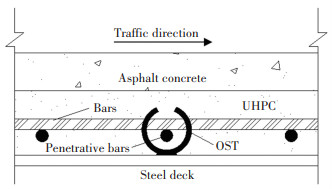
|
Fig.1 Composite deck with OST connector |
This paper investigates the shear behavior and failure mechanism of OST connectors in steel-UHPC composite decks, including the influence of the rebars. The corresponding push-out test model was established finite element model (FEM) in the software ABAQUS, and the full-process analysis of the OST connectors was carried out.
1 Push-Out Test 1.1 SpecimensA total of six push-out specimens were tested. These specimens were classified into two groups, with three duplicate specimens in each group. Specimens in the first group did not have any rebar in the UHPC deck, while specimens in the second group had rebars in the UHPC deck.
Push-out specimens were designed according to Eurocode 4[15]. There were eight connectors welded on the steel beams with a vertical central spacing of 200 mm and transverse central spacing of 170 mm. The open tube had an opening width of 16 mm. The covering thickness and connector specifications in China were used to set the specimen dimensions. The specimen designs are listed in Table 1, and the specimen dimensions are shown in Fig. 2.
| Table 1 Specifications of specimens for each group |
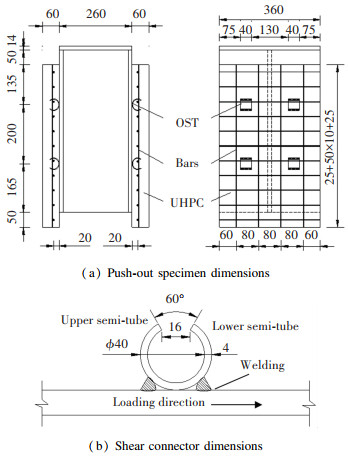
|
Fig.2 Structural dimensions (mm) |
1.2 Specimen Fabrication
The mix proportion of UHPC is shown in Table 2. The linear copper-plated cold-drawing steel fibers used was 13 mm in length and 0.18-0.22 mm in diameter, and had a tensile strength greater than 2850 MPa. For compressive loading, UHPC with 3% steel fibers by volume has a good toughness and crack resistance that makes it suitable for application in a bridge deck[16]. The powder materials that form agglomerations around steel fibers in UHPC were avoided by first mixing the dry-mixture materials for 4 min added in the order of aggregate, steel fibers, cement, and mineral admixture. Then, water and the water reducer were added and mixed for more than 4 min. The outer surface of the steel plates was smeared with lubricating oil to eliminate friction between the steel and UHPC.
| Table 2 Mix ratio for UHPC |
Following the initial setting, the UHPC was cured at ambient temperature as water was sprinkled for 48 h onto a soaking felt fabric that was placed on the surface of the UHPC. Then, the specimens were wrapped up in a thermal insulation plastic film for steam curing. Steam curing had three stages: heating, constant temperature, and cooling. The heating and cooling rates were controlled to be 12 ℃/h. The temperature of the holding stage was 90-100 ℃ that was maintained for up to 72 h.
1.3 Material PropertiesThe material test data for the various steel components are shown in Table 3. During casting, standard UHPC prisms of 100 mm × 100 mm ×300 mm and cubic specimens of 100 mm in size were formed and cured with the same curing conditions to measure the material properties. These UHPC properties are given in Table 4.
| Table 3 Property test results for steel |
| Table 4 Property test results for UHPC |
1.4 Loading Method
An electro-hydraulic servo compression-testing machine was used with a maximum jacking displacement of 400 mm that provided a limiting reaction load of 10000 kN. At the start of loading, a jack moved the specimen upwards gradually, as shown in Fig. 3. A balanced and distributed load was ensured by placing 2 cm of quartz sand on the support floor and a 5 mm-thick rubber pad on top of the specimen.

|
Fig.3 Schematic of test setup |
As shown in Fig. 4(a), a total of four displacement meters were employed to determine the relative slip between the steel and UHPC during loading. The stress state of the specimens was detected, and eccentric loading was prevented by using strain gauges that were pasted on the inside of the steel beam at the connector welding centers, as shown in Fig. 4(b). The push-out test is as shown in Fig. 4(c).
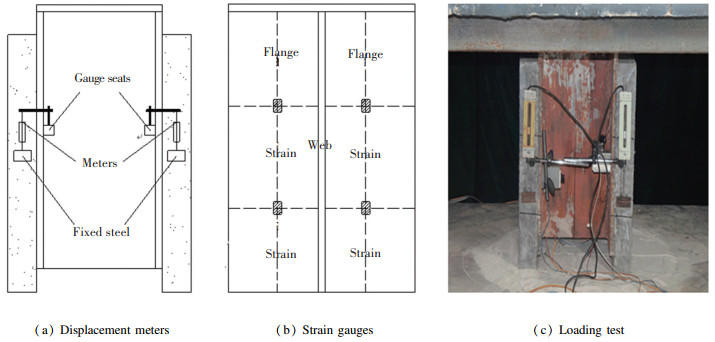
|
Fig.4 Arrangement of measurement equipment |
Three strain gages were horizontally arranged at equal spacing on the inner side of the I-shaped steel flange plate corresponding to the welding center of the connector, so there were eight groups of 24 strain gages in total for each push-out test piece.
The monotonic loading method was used to load the specimen to 30% of the estimated ultimate load in stages. After it was stabilized, it was unloaded to zero at the same speed. Repeat this way to eliminate the friction between the concrete slab and the I-shaped steel flange plate as much as possible, and let the specimen self-leveling reduce the impact of the initial defect of the specimen until the readings of various instruments were normal and the specimen had been adjusted, then start the official loading. First, the method of force control loading was used to gradually load to 70% of the estimated ultimate load; then, the displacement control was changed to slowly load at a small displacement loading rate to obtain a smoother data curve; when the load reached the highest point and reduced to 80% of the ultimate load, the displacement loading rate was accelerated until the UHPC plate and I-beam were completely separated, and the load in the loading process was recorded as the peak value of the ultimate load of the specimen.
2 Test Results 2.1 Specimens in Group AThe preloading was repeated until the readings were stable. After the preloading procedure, the specimen was loaded at a speed of 2 kN/s, and strain and displacement data were collected at increments of 20 kN. Above 320 kN, the loading speed was reduced to 1 kN/s and readings were collected at increments of 10 kN. When 560 kN was reached, the loading mode was changed to displacement control and the speed was set to 0.2 mm/min. As the load increased to 890 kN, the loading speed decreased, indicating that plastic deformation had occurred. The test load reached 1194 kN and shortly after the load suddenly reduced to about 1090 kN and was accompanied by a loud sound. Subsequently, the load gradually increased again to about 1140 kN. After this second peak, the test load slowly decreased to 1020 kN as connectors were pulled out with a loud noise as they became completely separated from the UHPC plate. A typical specimen after failure is shown in Fig. 5. The OST connector was sheared off at its lower semi-tube during loading, but the test continued until pull-out failure of the upper semi-tube occurred as shown in Fig. 6.
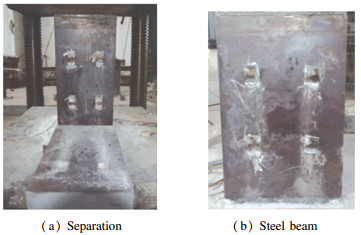
|
Fig.5 Specimen failure |
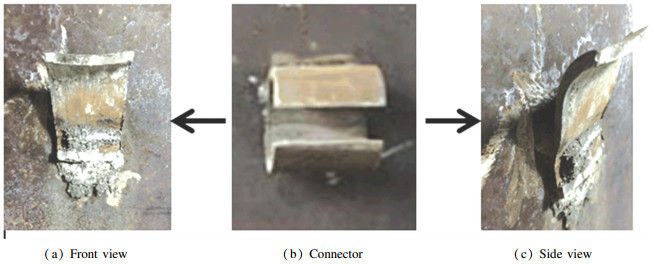
|
Fig.6 Failure pattern of OST connector |
The crack distribution and failure mode of a UHPC plate are illustrated in Figs. 7 and 8, respectively. Most cracks were mainly concentrated in the concrete around the upper row of connectors. There were only a few visible cracks in the concrete around the lower row of connectors.
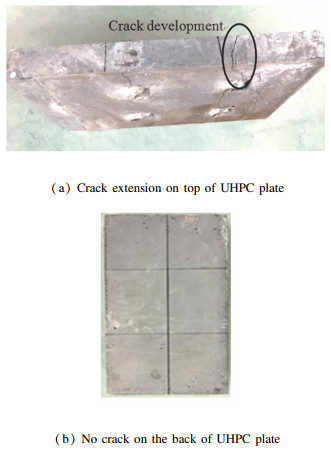
|
Fig.7 Crack distributions in Group A |
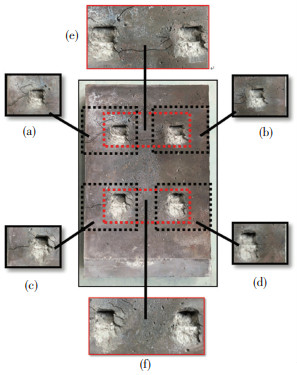
|
Fig.8 Failure mode of UHPC plate |
2.2 Specimens in Group B
The observations of the Group B tests were similar to those of Group A. However, the crack distribution of the UHPC plate differed between these two groups. For specimens in Group A, most cracks were concentrated in the concrete around the upper row. In Group B, there was almost an equal number of cracks generated in the concrete near the upper and lower rows of connectors as shown in Fig. 9. The cracks extended through the full section of concrete in Group A. In Group B, the cracks extended to the 1/2 sectional depth as revealed from the top of the concrete plate as shown in Fig. 10.

|
Fig.9 Crack distributions on UHPC plate |
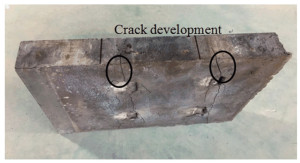
|
Fig.10 Crack distributions on the top in Group B |
3 Test Analysis 3.1 Load-Slip Parameters
The shear capacity and stiffness of the connector can be obtained directly from the load-slip curve and is often used for the analysis of a push-out test. Using a typical load-slip curve shown in Fig. 11, the test parameters are described as follows[17]:
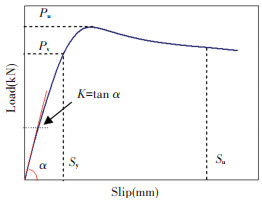
|
Fig.11 Parameter definitions in a load-slip curve |
1) Ultimate shear capacity Pu: the peak load of a load-slip curve, and the shear capacity Fu is determined for one connector.
2) Yield shear capacity Py: the yield load corresponding to the boundary between elastic and elastoplastic segments in a load-slip curve.
3) Limiting slip Su: a limiting slip is determined from the slip value corresponding to 0.85Pu post the peak load if a descending segment exists. Otherwise, a maximum slip value in a load-slip curve is taken to be the limiting one.
4) Shear stiffness K: a secant slope of 1/3 Pu in a load-slip curve. The shear stiffness is determined for one connector.
5) Yield and limit stiffness Ky: a slope of Py/Sy determines the yield stiffness where Sy is the slip corresponding to the yield shear capacity Py. The limit stiffness is Ku=Pu/Su, and the yield and limit stiffness is determined for one connector.
6) Ductility factor μ = Su/Sy.
3.2 Load-Slip Curves in Group AA casting error or initial defects of the specimen caused four load drops during the loading of A-1. Only two load drops occurred in the specimen A-2 and A-3. The lower number of load drops suggest that these two specimens were subject to more uniform loading and that the connectors were sheared off together. The load-slip curves of Group A can be divided into four stages as shown in Fig. 12.

|
Fig.12 Load-slip curves of Group A |
The first stage (A-B) was the elastic region with elastic limiting capacity of 0.70-0.75Pu. The second stage (B-C) was the elastoplastic region in the range of 0.70-0.90Pu. The ultimate slip in this stage can reach 0.35Su, as the curve flattens out. The third stage (C-D) was the plastic development stage in the range of 0.90-1.00Pu. The load-slip curve in this stage was close to a straight line, as slip increased rapidly for a small increase in the load. The ultimate slip in this stage was up to 0.55Su. The last stage (D-E) was the failure stage. In this stage, there were two declines in the load-slip curve. The first sudden decline was attributed to the shear fracture of the lower semi-tube. After this shear fracture, the shear stress was distributed to the upper semi-tube and weld. This transfer caused a small rise in load, and then induced another sudden but smaller fall in the load-slip curve.
3.3 Load-Slip Curves in Group BThe load-slip curves of Group B shown in Fig. 13 can also be divided into four stages. The elastic region (A-B) had an elastic peak load of 0.60-0.70Pu. The second stage (B-C) was the elastoplastic region with a load of 0.65-0.85Pu. The plastic development (C-D) stage was between 0.85-1.00Pu. The failure stage (D-E) showed a notable decrease in the shear capacity.
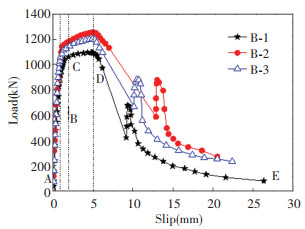
|
Fig.13 Load-slip curves of Group B |
3.4 Result Comparison
The middle curves of each group are A-3 and B-3 and are shown for comparison in Fig. 14. The first halves of the curves were close to each other. However, the decrease of shear capacity after the peak load in Group B was much larger than that in Group A. Also, the relative slip of Group B after the peak load was greater, indicating that the steel mesh which was arranged in the OST restrained the slip of the connector for high-strength of reinforcement and led to a smaller Su but can effectively increase the toughness of the specimen. Test parameters of specimens in two groups are summarized in Table 5.

|
Fig.14 Comparison for specimens in two groups |
| Table 5 Test parameter results for specimens in each group |
Comparing the test parameters reveals a few differences between the two groups that are summarized as follows:
1) The mean yield load of the reinforced specimens was about 10% higher than that of the unreinforced one. The ultimate shear capacity in the two groups was relatively close.
2) The mean yield slip of the reinforced specimen was around 46% higher than that of the unreinforced one. However, the ultimate slip of the reinforced specimen was approximately 32% lower.
3) The ductility factors of the specimens were more than three, demonstrating this composite structure possessed certain deformation capacity[11]. The ductility factor of the specimen without reinforcement was about 55% higher.
4) The shear stiffness of the reinforced specimen was approximately 16% higher. For each specimen, the limit stiffness was far less than its shear and yield stiffness. In comparison with shear stiffness, the limit stiffness of the specimen in the two groups decreased by 89%-93%. This result shows that there was a significant stiffness reduction due to the plastic deformation process.
4 Finite Element Analysis 4.1 Element TypeThe finite element software ABAQUS/Standard 6.14 has excellent nonlinear analysis capabilities, and it was utilized in the numerical simulations of the push-out specimens in this study. The steel mesh was simulated using the three-dimensional deformable truss element T3D2. The C3D8R was used for the UHPC layer, OST, and steel plates. The UHPC layers and OST were cut into regular element shapes to improve calculation accuracy in handling the stress concentration area caused by the discontinuous structure in the model.
The UHPC plate and OST model were cut into relatively discrete areas to obtain a relatively simple geometric structure, so that the standard grid pattern was applied to each component, and a structured grid with high calculation accuracy and good convergence effect was divided.
Fig. 15 shows the FEM of the 1/2 push-out specimen with open tubes that was established using the symmetry of the geometric structure, boundary conditions, and contact relationship. Fig. 16 shows the FEM of OST.

|
Fig.15 Symmetric model of push-out specimen |

|
Fig.16 OST model |
The constitutive models of the UHPC and OST in the FEM used parameters measured in the material tests. The stress-strain curves for each component of the model are shown in Fig. 17.
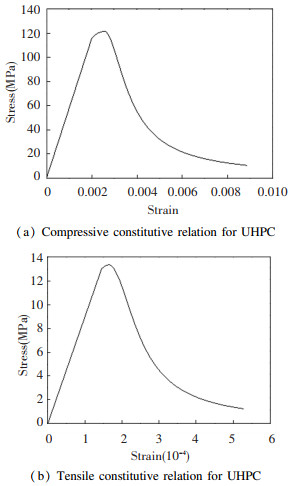
|
Fig.17 Constitutive curves |
4.2 Numerical Investigation
A complete load-slip curve was obtained through processing numerical results of half of the model. The load-slip curves were compared up to the limiting slip Su, as illustrated in Fig. 18. The finite element curves were close to the test curves in the elastic stage. In this stage, the simulated shear stiffness for one open tube of 193.7 kN/mm in Group A and 196.2 kN/mm in Group B was close to the mean measured values of 208.8 kN/mm and 213.3 kN/mm in that order, and the errors were approximately 7.2% and 8.0%. In the elastoplastic and plastic stages, the model capacity increased at a slower rate with the increase of slip than the values from testing. Thus, the simulated ultimate shear capacity of 147.6 kN in Group A and 147.2 kN in Group B for one open tube had an error of about 2.3% and 1.4% relative to the measured means of 151.0 kN and 149.3 kN, respectively. Though the numerical results were slightly lower than the measured ones, the errors were within 10%, and the trend of the simulated curve was close to the test curves. Therefore, it is considered that the numerical simulation can reflect the stress condition and deformation of the connectors with UHPC. Thus, the model can be used to explore the failure mechanisms of the specimens.
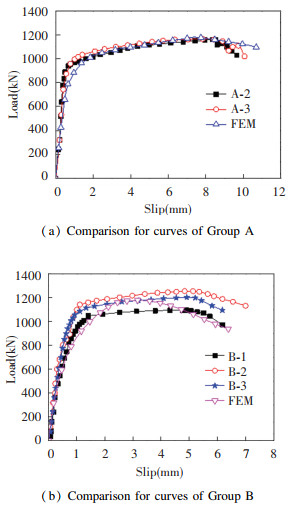
|
Fig.18 Comparison of test and simulated curves |
A cylindrical coordinate system was established in Fig. 19(a). Stress sample points at the connector were taken clockwise at the radius R=20 mm and the equal-angle interval θ =45°. The stress diagrams formed from these sample points are shown in Fig. 19(b) and 19(c).

|
Fig.19 OST model |
The Mises stresses for each point with the displacements of 0.2Su, 0.4Su, 0.6Su, 0.8Su, and 1.0Su were measured and are shown in Fig. 20. The Mises stress significantly increased when moving from the lower semi-tube to the upper one. The maximum stress was on the connector root. The stress of the tube root at θ=140-180° increased significantly and exhibited a distinct stress concentration. This stress concentration led to the fracture failure of the lower semi-tube. This result from the model is in accordance with the failure pattern observed from testing. In the upper semi-tube, stress tended to decrease linearly within a large range. Beyond 225°, the stress was close to zero and revealed that the upper semi-tube was not fully utilized. Thus, the shear loading was transferred to the upper semi-tube after the first sudden decline caused by connector fracture. This transfer of the shear load caused a brief rise in shear capacity and further postponed the specimen failure. This numerical result is similar to the test observations.

|
Fig.20 Mises stress distributions in OST |
The results show that the stress state of the upper and lower semi-tubes of the OST is quite different. The lower semi-tubes is mainly affected by horizontal shear, while the upper semi-tubes is mainly affected by vertical tension, and the shear capacity is mainly provided by the lower semi-tubes.
The main compressive stress diagrams of the UHPC plate are shown in Fig. 21. The maximum compressive stress of UHPC was at lower semi-tube. In the ultimate state of bearing capacity, the concrete was crushed. Because of high compressive of UHPC, the stress caused limited failure.
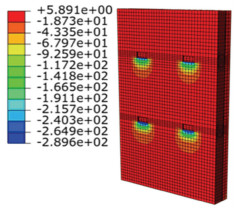
|
Fig.21 Mises stress distributions in symmetric model |
4.3 Composite and OST Behavior
The behavior of the composite specimen with OSTs can be determined from the push-out test and the FEM model. The concrete inside the OST was confined by the OST walls during the loading process, and the corresponding concrete compressive strength was improved under the confinement effect. However, the displacement of concrete outside the tube was larger than that inside the tube since there was no confinement effect there. Therefore, tensile stress in the concrete appeared on both sides of OST due to the displacement difference. The bridging action of steel fibers in the concrete matrix slowed the progression of cracks caused by tensile stress, and the deformation of the connectors gradually increased. As the load was passed, a small amount of local crushing developed from the interactive compression between the OST root and UHPC as shown in Fig. 22(a). Then, the connector arrived at the ultimate strain, and the root of the lower semi-tube was sheared off, as illustrated in Fig. 22(b). Following the fracture of the lower semi-tube, shear stress was shared by the upper semi-tube and the weld. The low shear capacity of the upper semi-tube caused the OST to separate and to be pulled out from the UHPC plate rapidly as shown in Fig. 22(c). For the reinforced specimen, stress distribution in the damaged region continued even after cracks developed and connector fracture occurred. The bonding effect and mechanical interaction between the reinforcement and concrete gave uniform stress through the concrete and wrapped reinforcement to the cross-section. This uniform stress caused limited cracks to form in the upper and lower rows of the grooves that had a relatively small cracking depth.
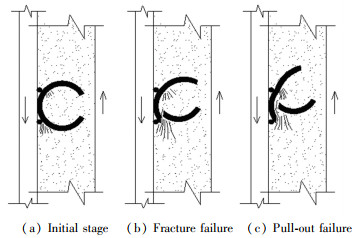
|
Fig.22 Failure processes for push-out specimen |
5 Conclusions
A steel-UHPC composite bridge deck with OSTs was investigated using push-out tests and FEM to study the stress behaviors and shear performances. The following conclusions were drawn:
1) The ultra-high compressive strength and superior toughness of UHPC caused the failure mode of the push-out specimen to be shear fracture at the root of the lower semi-tube, followed by pull-out failure of the upper semi-tube. A small amount of concrete crushing and a few local cracks appeared in the UHPC plate.
2) The deformation of the composite specimens was divided into four stages: elastic, elastoplastic, plastic, and failure stages. In the middle two phases, the slip increased rapidly, and shear capacity remained fairly stable. In the failure stage, there was a secondary load increase and peak in the curve indicating the specimen had a good energy dissipation behavior.
3) Ductility factors of all specimens were greater than three, demonstrating this composite structure possesses some deformation capacity. However, the ductility behavior failed to meet the requirements of Eurocode-4, and it is recommended that the open-tube connector should be designed using the elastic principle.
4) The mean yield load of the specimen reinforced with reinforcement was about 10% higher than that of the unreinforced one. The ultimate shear capacity of the two groups was relatively close. The ultimate slip of the reinforced specimen was about 32% lower, and shear stiffness of reinforced specimen was about 16% higher.
5) An FEM model was verified to be accurate and used to study the loading and failure processes. Results of the simulation reveal that there is a stress concentration zone at the OST root and that the lower semi-tube is the main component subjected to loads. The steel mesh reinforcement effectively made the stress distribution uniform and restricted the crack development in the UHPC plate.
| [1] |
Allahyari H, Dehestani M, Beygi M H A, et al. Mechanical behavior of steel-concrete composite decks with perfobond shear connectors. Steel & Composite Structures, 2014, 17(3): 339-358. DOI:10.12989/scs.2014.17.3.339 (  0) 0) |
| [2] |
Noel M, Wahab N, Soudki K. Experimental investigation of connection details for precast deck panels on concrete girders in composite deck construction. Engineering Structures, 2016, 106: 15-24. DOI:10.1016/j.engstruct.2015.10.002 (  0) 0) |
| [3] |
Kim J S, Kwark J, Joh C, et al. Headed stud shear connector for thin ultrahigh-performance concrete bridge deck. Journal of Constructional Steel Research, 2015, 108: 23-30. DOI:10.1016/j.jcsr.2015.02.001 (  0) 0) |
| [4] |
Xu C, Su Q T, Masuya H. Static and fatigue behavior of the stud shear connector in lightweight concrete. International Journal of Steel Structures, 2018, 18: 569-581. DOI:10.1007/s13296-018-0014-1 (  0) 0) |
| [5] |
Eray B, Cem T. An experimental study on channel type shear connectors. Journal of Constructional Steel Research, 2012, 74: 108-117. DOI:10.1016/j.jcsr.2012.02.015 (  0) 0) |
| [6] |
Rodrigues J P C, Laím L. Behaviour of Perfobond shear connectors at high temperatures. Engineering Structures, 2011, 33(10): 2744-2753. DOI:10.1016/j.engstruct.2011.05.004 (  0) 0) |
| [7] |
de LimaAraúj D, Sales M W R, de Paulo S M., et al. Headed steel stud connectors for composite steel beams with precast hollow-core slabs with structural topping. Engineering Structures, 2016, 107: 135-150. DOI:10.1016/j.engstruct.2015.10.050 (  0) 0) |
| [8] |
Shao X D, Yi D T, Huang Z Y, et al. Basic performance of the composite deck system composed of orthotropic steel deck and ultrathin RPC layer. Journal of Bridge Engineering, 2013, 18(5): 417-428. DOI:10.1061/(ASCE)BE.1943-5592.0000348 (  0) 0) |
| [9] |
Dieng L, Marchand P, Gomes F, et al. Use of UHPFRC overlay to reduce stresses in orthotropic steel decks. Journal of Constructional Steel Research, 2013, 89(5): 30-41. DOI:10.1016/j.jcsr.2013.06.006 (  0) 0) |
| [10] |
Lampropoulos A P, Paschalis S A, Tsioulou O T, et al. Strengthening of reinforced concrete beams using ultra high performance fibre reinforced concrete (UHPFRC). Engineering Structures, 2016, 106: 370-384. DOI:10.1016/j.engstruct.2015.10.042 (  0) 0) |
| [11] |
Wang J Y, Guo J Y, Jia L J, et al. Push-out tests of demountable headed stud shear connectors in steel-UHPC composite structures. Composite Structures, 2017, 170: 69-79. DOI:10.1016/j.compstruct.2017.03.004 (  0) 0) |
| [12] |
American Institute of Steel Construction Inc., ANSI/AISC 360-05. Specification for Structural Steel Buildings. Chicago: American Institute of Steel Construction, Inc., 2005.
(  0) 0) |
| [13] |
Kang J Y, Park J S, Jung W T, et al. Evaluation of the shear strength ofperfobond rib connectors in ultra high performance concrete. Engineering, 2014, 6(13): 989-999. DOI:10.4236/eng.2014.613089 (  0) 0) |
| [14] |
Aarup B, Jensen L R. Compact reinforced concrete CRC applications of fiber-reinforced high-performance concrete. Betonwerk und Fertigteil-Technik, 2008, 74(10): 18-26. (  0) 0) |
| [15] |
European Committee for Standardization. Eurocode 4: Design of Composite Concrete and Steel Structures. Belgium: European Committee for Standardization, EN1994: 2005. London: British Standards Institution, 2005.
(  0) 0) |
| [16] |
Wu Z M, Shi C J, He W, et al. Effects of steel fiber content and shape on mechanical properties of ultra high performance concrete. Construction & Building Materials, 2016, 103: 8-14. DOI:10.1016/j.conbuildmat.2015.11.028 (  0) 0) |
| [17] |
Zhao Q, Cai W P, Chen C B. Experimental study on shear strength of steel-RPC composite deck with flat steel plate connectors. Engineering Mechanics, 2017, 34(8): 171-179. (in Chinese) DOI:10.6052/j.issn.1000-4750.2016.04.0326 (  0) 0) |
 2021, Vol. 28
2021, Vol. 28


